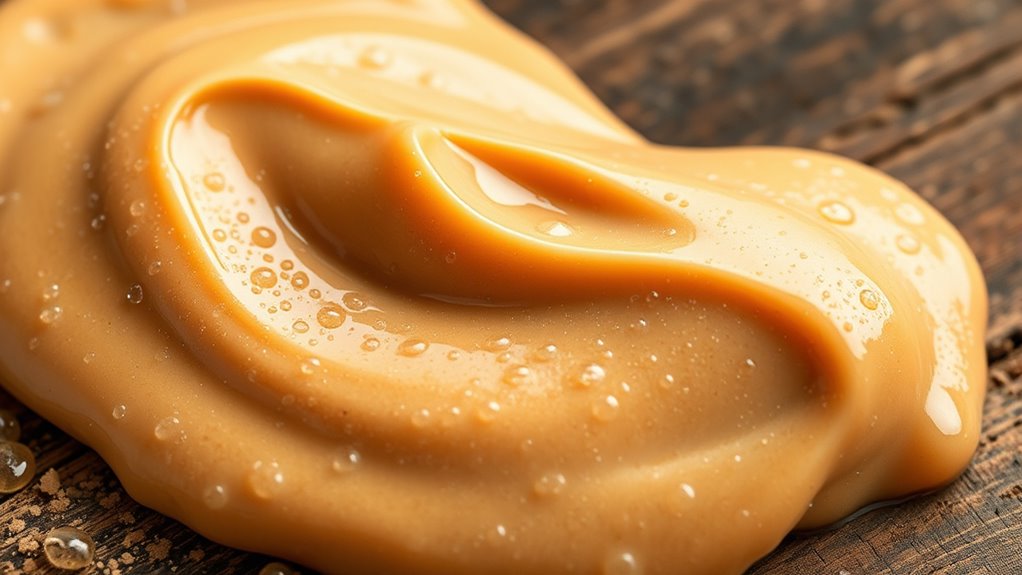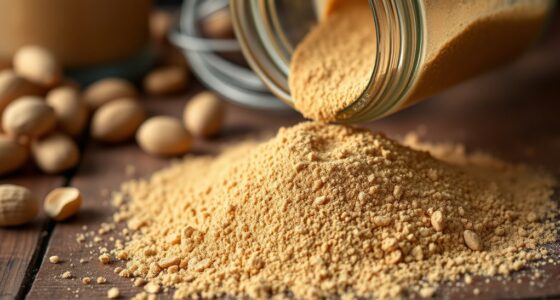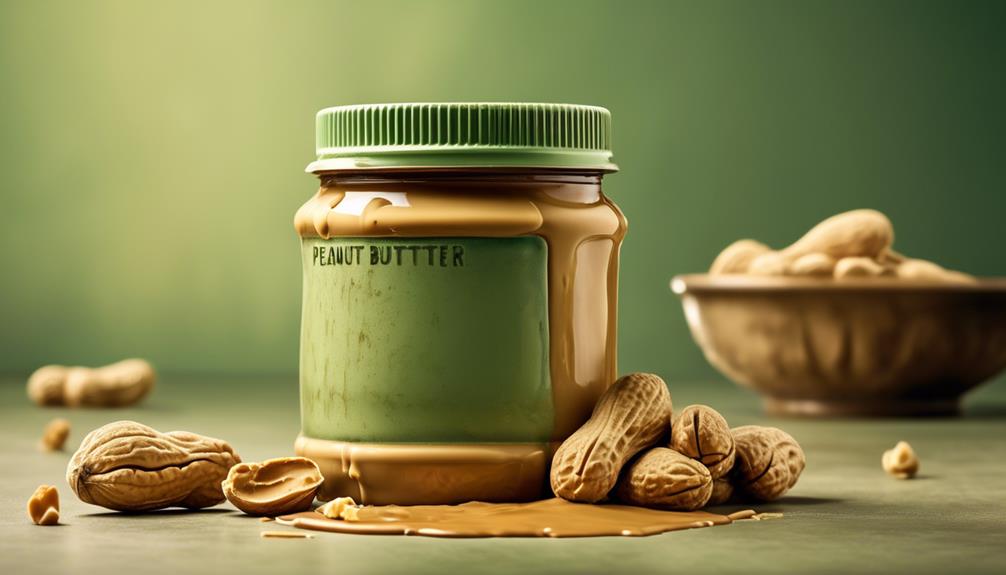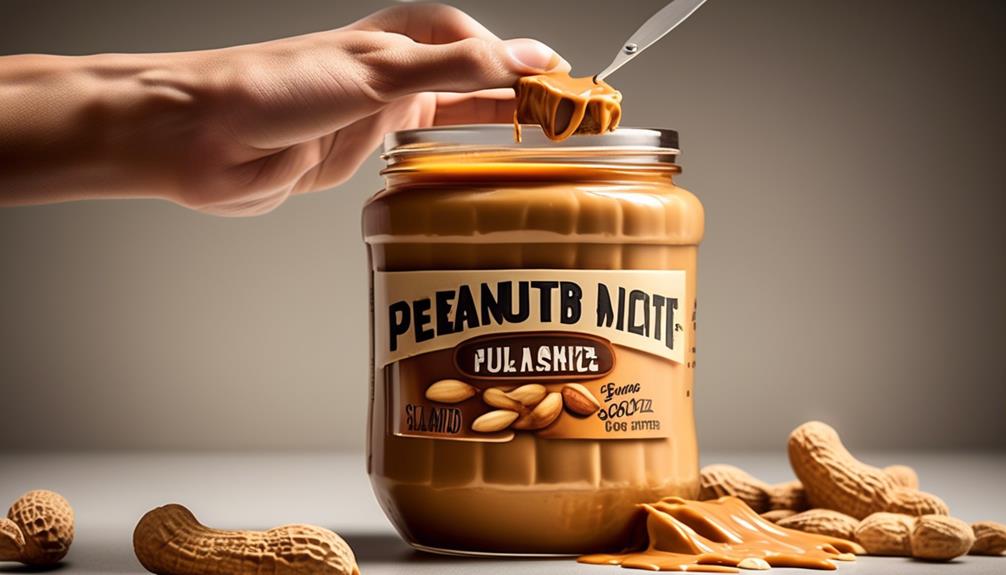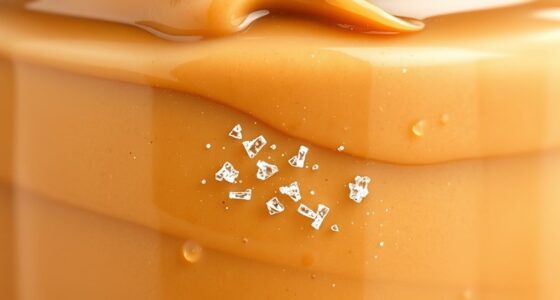Emulsifiers play a vital role in stabilizing peanut butter by creating a barrier between oil and water components, preventing oil separation and maintaining a smooth, uniform texture. They do this by lining up at the oil-water interface, reducing surface tension, and surrounding oil droplets to keep them evenly dispersed. This helps guarantee consistent spreadability and shelf life. To learn how these ingredients improve quality and stability, keep exploring the details.
Key Takeaways
- Emulsifiers blend oil and water components, creating a stable, uniform peanut butter by preventing separation.
- They surround oil droplets with protective barriers, reducing coalescence and maintaining a smooth, creamy texture.
- Emulsifiers improve product stability and extend shelf life by resisting oil separation and spoilage.
- They ensure consistent spreadability and prevent graininess or clumping during application.
- Natural and artificial emulsifiers are chosen to balance stability, safety, consumer preferences, and label transparency.
Understanding the Basics of Emulsifiers
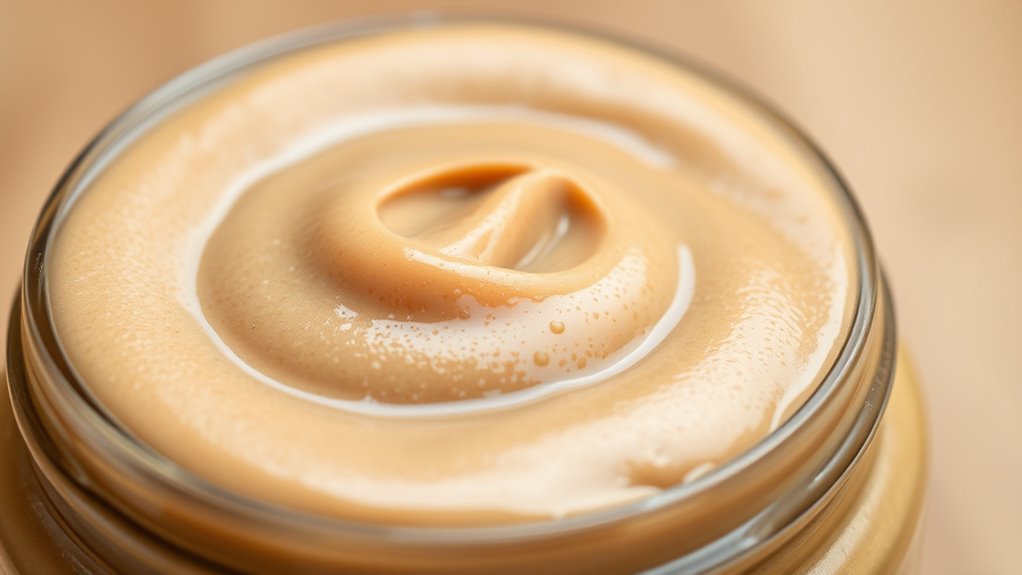
Emulsifiers are additives that help blend ingredients that normally don’t mix well, such as oil and water. You should understand emulsifier chemistry, which involves molecules with both hydrophilic (water-loving) and lipophilic (oil-loving) parts. These molecules act as bridges, reducing tension between different ingredients and promoting stable mixtures. When you add an emulsifier, it interacts with both oil and water, creating a barrier that prevents separation. This improves the texture and consistency of products like peanut butter. Understanding ingredient interactions is key to knowing how emulsifiers work—they facilitate the formation of a uniform emulsion by lining up at the interface of oil and water, allowing these ingredients to coexist smoothly. The high contrast ratio in emulsifier function helps achieve clearer separation of phases, which is crucial for product stability and appearance. This foundational knowledge helps you appreciate how emulsifiers contribute to product stability.
How Emulsifiers Prevent Oil Separation
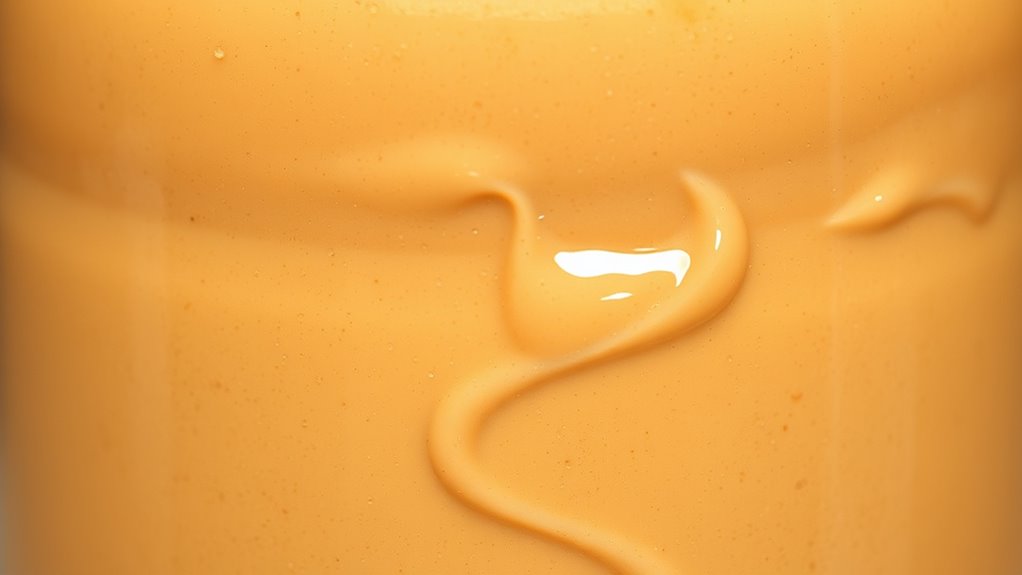
You might notice that emulsifiers keep the oil evenly mixed with the peanut butter, preventing separation. They do this by binding oil and water molecules together through their molecular structure. This action creates a stable emulsion, so the oil stays suspended rather than rising to the top. Incorporating proper stabilizers can further enhance the stability and texture of the product.
Oil Binding Mechanism
Oil separation in peanut butter occurs when the natural oils rise to the surface over time, creating an unappealing layer. Emulsifiers help prevent this by binding the oil within tiny droplets, maintaining a stable emulsion. The key is controlling oil droplet size; smaller droplets resist coalescing and rising, which enhances emulsion stability. Emulsifiers surround each oil droplet with a protective layer, reducing surface tension and preventing the droplets from merging. This process keeps the oil evenly distributed throughout the product, ensuring it remains creamy and uniform. When oil droplet size remains small, the emulsion stays stable longer, delaying separation. By effectively binding the oil, emulsifiers maintain the desired texture, appearance, and consistency of peanut butter throughout its shelf life.
Emulsifier Molecular Action
To prevent oil separation, emulsifiers work at the molecular level by surrounding oil droplets with their hydrophobic and hydrophilic regions. This molecular interaction stabilizes the mixture by reducing surface tension and preventing droplets from coalescing. The emulsifier’s structure is key, with one end attracted to oil and the other to water, forming a protective barrier around each droplet. This barrier keeps oil evenly dispersed within the aqueous phase. Additionally, understanding Volkswagen Tuning principles can help optimize formulations for better stability and performance.
Common Emulsifiers Used in Peanut Butter
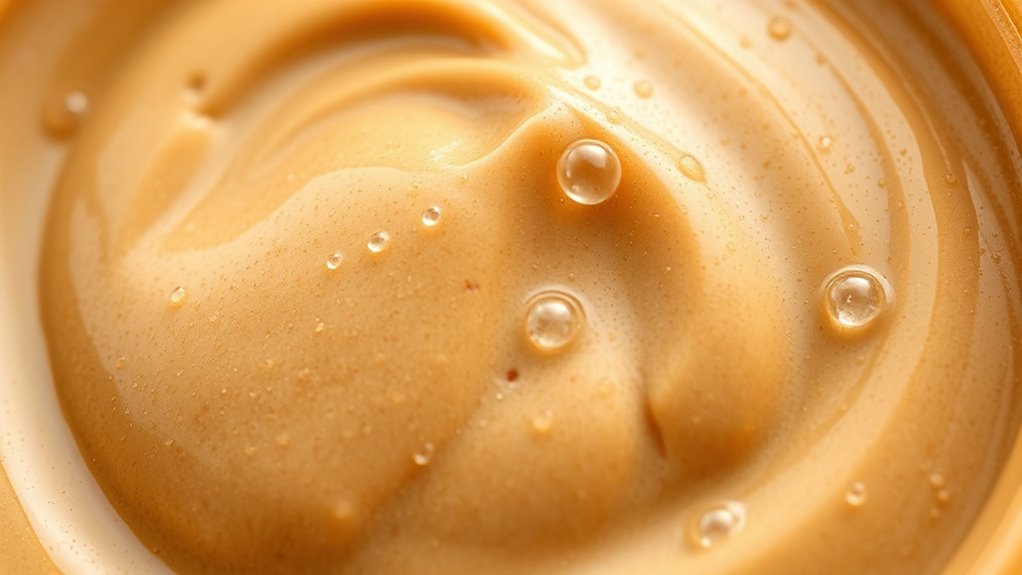
You’ll find several types of emulsifiers in peanut butter, each designed to keep the product smooth and uniform. These emulsifiers work by stabilizing the mixture and preventing oil from separating out. Understanding how they function helps you recognize their role in maintaining peanut butter’s texture and consistency. Additionally, the use of emulsifiers must comply with regulatory standards to ensure safety and transparency for consumers.
Types of Emulsifiers
Several emulsifiers are commonly added to peanut butter to guarantee a smooth, uniform texture and prevent oil separation. These emulsifiers fall into various classifications based on their chemical structure, such as lecithins, mono- and diglycerides, and phosphates. You might also find natural emulsifier sources like lecithin derived from soy or sunflower seeds, which are favored for their natural origin. Understanding emulsifier classifications helps you identify which ingredients work best for your desired texture. Some popular types include:
- Lecithins (soy, sunflower)
- Mono- and diglycerides
- Phosphates
These options provide effective stabilization while catering to different dietary preferences and natural ingredient preferences. Recent advances in AI security highlight the importance of monitoring ingredient stability and safety in food production.
Functionality in Stabilization
Emulsifiers in peanut butter actively work to maintain a stable, uniform texture by preventing oil separation and guaranteeing consistent spreadability. They achieve this by facilitating strong lipid interactions that form a durable emulsion. These interactions help keep the oil evenly dispersed within the aqueous phase, enhancing emulsion stability over shelf life and use. Effective emulsification minimizes the separation of oil, preserving the desired creamy consistency. The emulsifiers create a barrier around oil droplets, reducing coalescence and maintaining the product’s homogeneity. This functionality is vital for consumer appeal and shelf stability. By promoting robust lipid interactions, emulsifiers guarantee peanut butter remains smooth, spreadable, and free from oil separation, even under varying storage conditions. Understanding production quantity variance can help manufacturers optimize ingredient use and improve product consistency over time.
The Science Behind Emulsification

The science behind emulsification explains how tiny droplets of oil and water can stay mixed together in peanut butter, despite their natural tendency to separate. This process depends on the emulsifier structure, which contains molecules with both hydrophilic and hydrophobic parts. These molecules act as bridges, facilitating molecular interactions that stabilize the mixture. When emulsifiers are added, they surround oil droplets, reducing surface tension and preventing coalescence. Key points include:
- Emulsifier structure allows molecules to interact with both oil and water phases.
- Molecular interactions form a protective barrier around droplets.
- This barrier maintains a uniform, stable blend over time.
- Developing emotional intelligence can enhance your ability to understand and manage complex systems like emulsification and teamwork, fostering greater confidence in problem-solving.
Understanding these principles helps you see how emulsifiers keeps peanut butter smooth and consistent.
Benefits of Using Emulsifiers in Peanut Butter
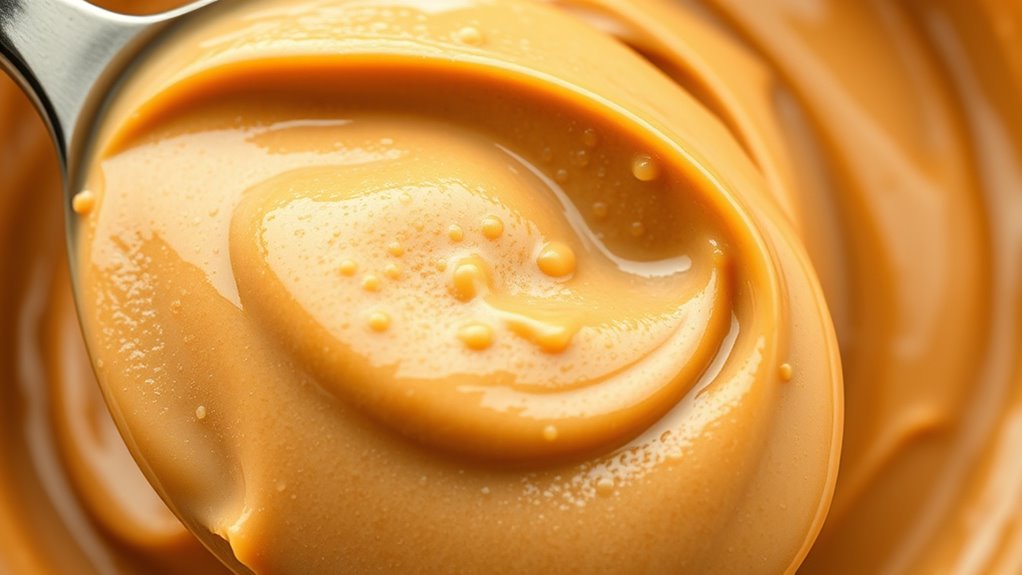
Using emulsifiers in peanut butter offers several benefits that enhance both its texture and shelf life. They help improve flavor enhancement by evenly distributing oils and solids, resulting in a more consistent taste. Emulsifiers also contribute to shelf life extension by preventing oil separation and spoilage, keeping your peanut butter fresher longer. This means you’ll enjoy a smoother, more appealing product over time. Additionally, emulsifiers promote better mixing during production, ensuring uniformity and reducing waste. They can also help maintain product stability during storage and transportation, preventing undesirable changes in texture or appearance. Overall, incorporating emulsifiers delivers a more stable, flavorful, and longer-lasting peanut butter experience.
Impact on Texture and Consistency
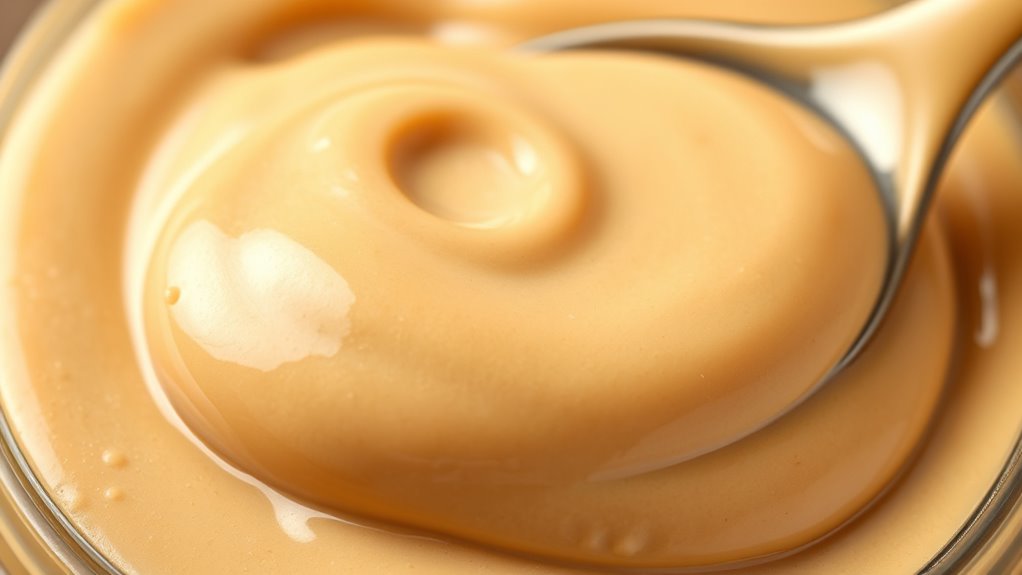
By guaranteeing even distribution of oils and solids, emulsifiers directly influence the texture and consistency of peanut butter. They help you achieve a smooth, creamy texture that feels pleasant on your palate. This also guarantees consistent spreadability, making it easier to apply without tearing the bread or clumping. With proper emulsification:
- You get a uniform, silky feel in each spoonful
- Oil separation is minimized, maintaining a stable texture
- The product remains smooth over time, resisting separation or graininess
These effects mean you enjoy a more enjoyable eating experience, with peanut butter that’s easy to spread and consistently creamy. Emulsifiers play a crucial role in maintaining the desirable qualities that make peanut butter appealing and user-friendly. Proper emulsification techniques help ensure these benefits are consistently achieved.
Safety and Regulatory Aspects
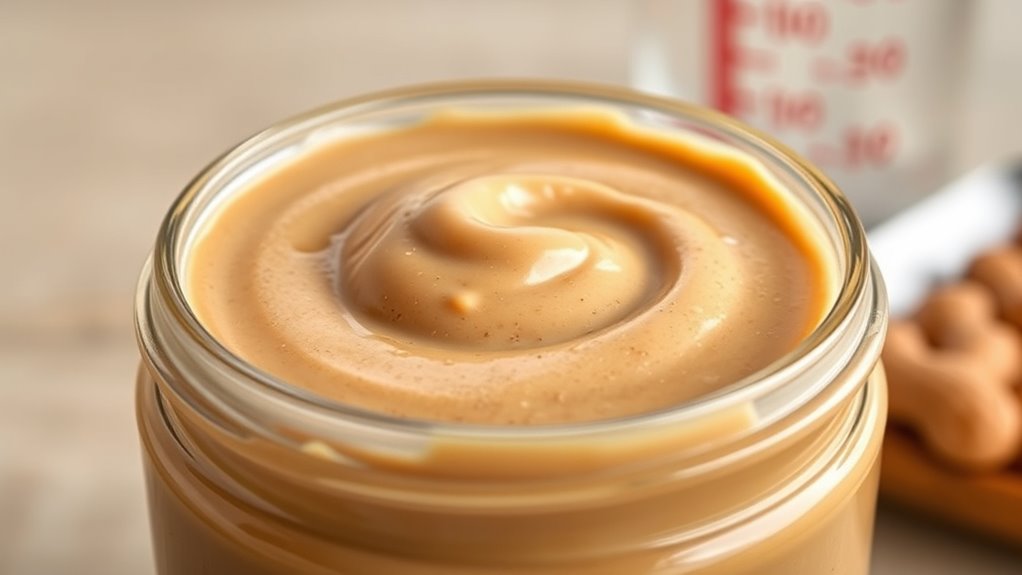
As emulsifiers become more common in peanut butter, guaranteeing their safety is essential for consumer confidence. Regulatory agencies, like the FDA, set strict standards to ensure these additives meet safety guidelines. You should be aware of potential food allergy concerns, especially with additives derived from nuts or soy, which could trigger allergic reactions. Compliance with regulations involves accurate labeling and ingredient transparency. To illustrate, consider the following:
| Emulsifier | Regulatory Status | Common Concerns |
|---|---|---|
| Soy lecithin | Generally Recognized as Safe (GRAS) | Food allergy risk |
| PGPR | Approved for use | Allergic reactions unlikely |
| Mono- and diglycerides | Approved | Minimal allergenic potential |
| Calcium stearoyl-2-lactylate | Approved | Food allergy considerations |
| Polysorbates | Approved | Monitoring for allergic responses |
Staying informed guarantees safety and regulatory compliance in peanut butter production. Understanding emulsifier safety standards helps producers maintain high-quality products and consumer trust.
Natural vs. Artificial Emulsifiers
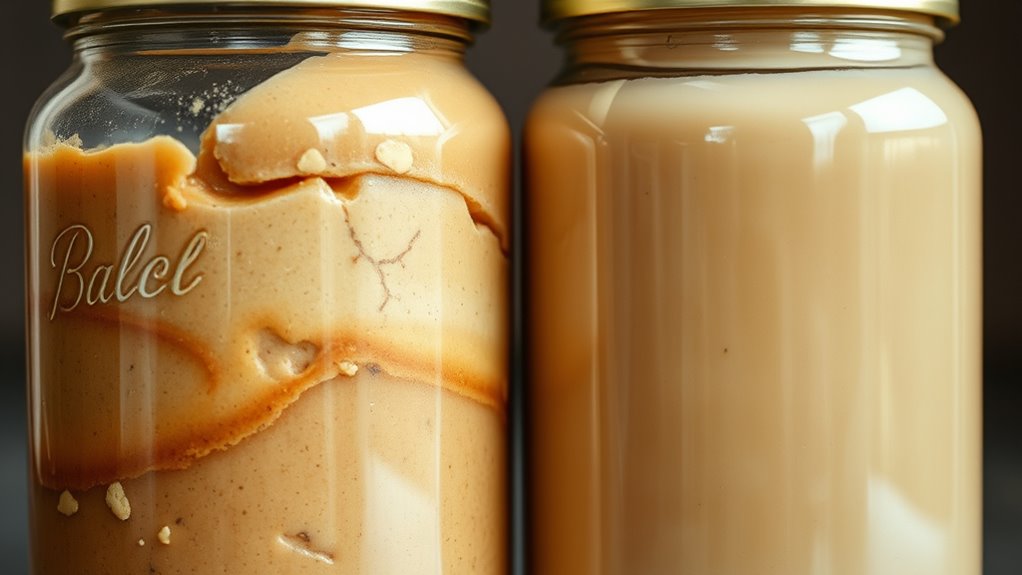
Have you ever wondered what distinguishes natural from artificial emulsifiers in peanut butter? Natural additives come from plant or mineral sources, offering a more “clean label” appeal. They often include lecithin from soy or sunflower, which helps blend fats and water naturally. Artificial stabilizers, on the other hand, are synthetic compounds designed for consistent performance and longer shelf life. They’re engineered to withstand heat and processing, ensuring stability.
- Natural additives are perceived as healthier and more eco-friendly.
- Artificial stabilizers provide reliable, uniform texture and extend shelf life.
- The choice often depends on consumer preference, cost, and product labeling regulations.
Understanding these differences helps you choose or formulate peanut butters aligned with your priorities for health, stability, and labeling.
Future Trends in Stabilized Peanut Butter Formulation
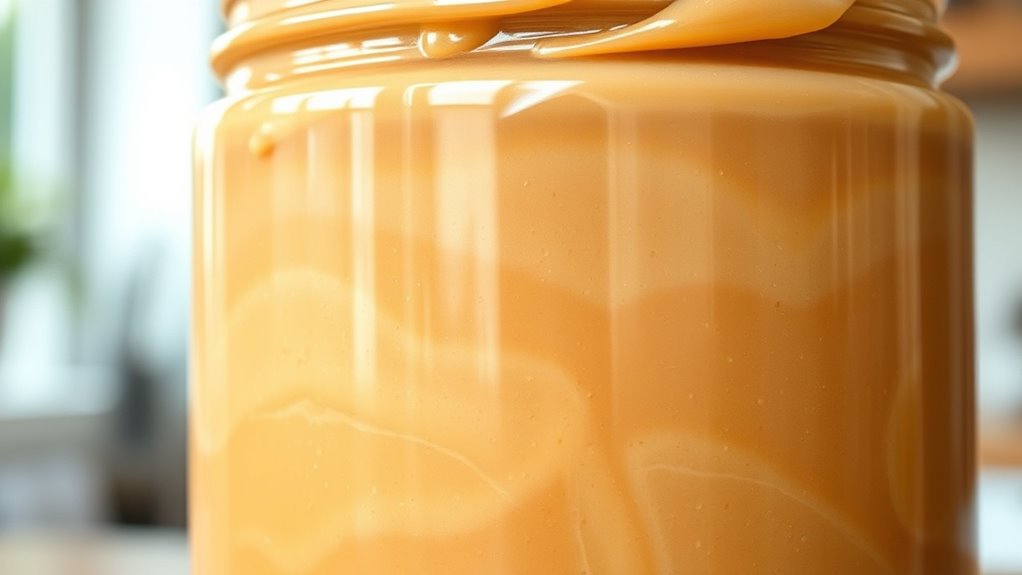
Emerging technologies and consumer preferences are shaping the future of stabilized peanut butter formulations. You’ll see a shift toward innovative ingredient combinations that enhance texture, flavor, and shelf life while reducing additives. Manufacturers are exploring natural emulsifiers and plant-based options to meet demand for cleaner labels. Sustainable formulation practices also take center stage, emphasizing eco-friendly sourcing and minimal environmental impact. You can expect more peanut butters made with biodegradable packaging and responsibly farmed ingredients. Advances in food science will enable the development of products that balance stability with health-conscious choices. These trends aim to satisfy consumers’ desire for transparency, sustainability, and high-quality ingredients, ensuring future stabilized peanut butter products are both innovative and environmentally responsible.
Frequently Asked Questions
How Do Emulsifiers Affect Peanut Butter’S Shelf Life?
Emulsifiers substantially impact peanut butter’s shelf life by enhancing emulsifier stability, which prevents oil separation over time. They create a more uniform mixture, reducing spoilage risks and maintaining texture. By improving stability, emulsifiers extend the product’s shelf life, ensuring it stays fresh longer. You’ll notice that with proper emulsifier use, your peanut butter remains smooth, consistent, and edible for an extended period.
Are There Allergen Concerns With Common Emulsifiers in Peanut Butter?
Think of emulsifiers as bridges connecting ingredients, but sometimes these bridges can carry unwanted baggage. You might wonder if common emulsifiers in peanut butter cause allergen cross reactivity or trigger emulsifier sensitivity. While most are considered safe, some individuals with food sensitivities may experience reactions. It’s wise to check labels and consult with a healthcare professional if you have known allergies or sensitivities, ensuring your peanut butter enjoyment stays safe and satisfying.
Can Homemade Peanut Butter Be Stabilized Without Emulsifiers?
You can stabilize homemade peanut butter without emulsifiers by using natural stabilization methods and ingredient alternatives. Try adding a small amount of honey, coconut oil, or lecithin, which help prevent separation and improve texture. Additionally, stirring the peanut butter regularly or storing it in an airtight container can maintain its consistency. These natural options are effective and reduce allergen concerns, giving you a healthier, homemade product without artificial additives.
Do Emulsifiers Alter the Flavor of Peanut Butter?
Did you know that some emulsifier types can subtly influence flavor? When you ask if emulsifiers alter peanut butter’s flavor, the answer varies. Certain emulsifiers, like lecithin, have minimal flavor impact, ensuring your peanut butter tastes just right. However, some artificial types might introduce a slight aftertaste. Overall, most emulsifiers are designed to stabilize texture without considerably changing flavor, allowing you to enjoy the classic peanut butter taste you love.
Are Emulsifiers Environmentally Sustainable in Peanut Butter Production?
You might wonder if emulsifiers are environmentally sustainable in peanut butter production. Emulsifiers can have varying environmental impacts depending on their sourcing and manufacturing processes. Opting for those with sustainable sourcing minimizes negative effects on ecosystems and reduces carbon footprints. By choosing brands committed to eco-friendly practices, you support better environmental impact and promote sustainable sourcing, making your peanut butter choice more environmentally responsible.
Conclusion
Emulsifiers truly play a essential role in keeping your peanut butter smooth and spreadable. While some believe they’re unnecessary, scientific evidence shows they effectively prevent oil separation and improve texture. Natural options can be just as effective as artificial ones, offering safer choices. So, next time you enjoy your favorite spread, remember that emulsifiers aren’t just additives—they’re key to enjoying consistent, delicious peanut butter every time.
